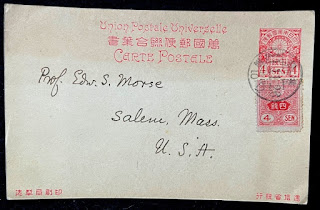Chujiro Sasaki writes:
Tokyo 28. V. 1924
Dear Sir,
Herewith, I say much thanks with your work - Joseph Leidy's Influence on Science - which I received with much interests.
Yours very faithfully
Hon. Prof. C. Sasaki
Agric. Coll. Tokyo Imp. Univ.
Tokyo (Komaba), Japan
 |
| 佐々木忠次郎からエドワード・S・モースへ1924年5月28日ジョゼフ・ライディ |
This postcard bears the date 28.V.1924 (28 May 1924), humorously marked with the Roman numeral 'V' to signify May. In a jesting manner, Chijiro Sasaki signs the card as 'Hon. Prof.,' a tongue-in-cheek reference to Honorable Professor, playfully expressing modesty in his signature.
Edward Morse likely sent Sasaki an article he authored on Joseph Leidy's Influence on Science, which was published in The Scientific Monthly, Vol. 18, No. 4 (Apr., 1924), pp. 422-427 (6 pages). In the opening paragraph of the article, Morse expresses his initial reluctance:
"It was with some hesitation that I accepted the invitation of
your committee to prepare an address on the subject of Joseph
Leidy's influence on the science of his time. It is true that I am
probably one of the oldest members of your academy, but it seemed
to me that a member nearer home and consequently more intimate
with Leidy's life and work would have been better chosen."
Chujiro Sasaki (1857-1938) stands as a noteworthy figure, having been a protégé of Edward S. Morse during his tenure at the University of Tokyo. As a student in 1877, Sasaki engaged in excavations and surveys at the Omori Shell Mound. In the subsequent years, he also explored the Okadaira Shell Mound, a site of significant archaeological import. Graduating from Tokyo University in 1881, Sasaki pursued further studies in Germany over a span of two years. His academic journey led him to eventually become a professor specializing in zoology, entomology, and sericulture at the Imperial University Agricultural College in 1893.
Joseph Leidy was an American paleontologist, anatomist, and naturalist who lived in the 19th century. He was born on September 9, 1823, in Philadelphia, Pennsylvania, and died on April 30, 1891. Leidy made significant contributions to various scientific fields, including paleontology, comparative anatomy, and parasitology.
Some key aspects of Joseph Leidy's life and work include:
- Education and Early Career:
Leidy attended the University of Pennsylvania, where he studied medicine and received his medical degree in 1844. While practicing medicine, Leidy developed an interest in natural history and anatomy, leading him to pursue scientific research.
- Paleontological Contributions:
Leidy is renowned for his contributions to paleontology. He conducted extensive research on fossilized remains, particularly those of prehistoric mammals and dinosaurs. In the mid-19th century, Leidy described and named several dinosaur species, including Hadrosaurus foulkii, one of the first nearly complete dinosaur skeletons found in North America.
Leidy also made important contributions to comparative anatomy, studying the anatomical structures of different species to understand their evolutionary relationships. His work included detailed studies of the skeletal anatomy of various animals, ranging from invertebrates to mammals.
Leidy was a pioneer in the field of parasitology, the study of parasites and their hosts. He made significant contributions to the understanding of parasitic organisms and their life cycles. His investigations into parasitology included the study of parasites affecting humans, animals, and even fossilized parasites found in coprolites (fossilized feces).
Joseph Leidy had a long and distinguished academic career. He served as a professor of anatomy at the University of Pennsylvania and the chair of anatomy at the Academy of Natural Sciences in Philadelphia. Leidy's teaching and mentorship influenced many aspiring scientists, and he played a key role in the development of paleontological and anatomical studies in the United States.
Joseph Leidy's work laid the groundwork for subsequent generations of scientists, and his legacy continues to be recognized in the fields of paleontology, comparative anatomy, and parasitology.

































